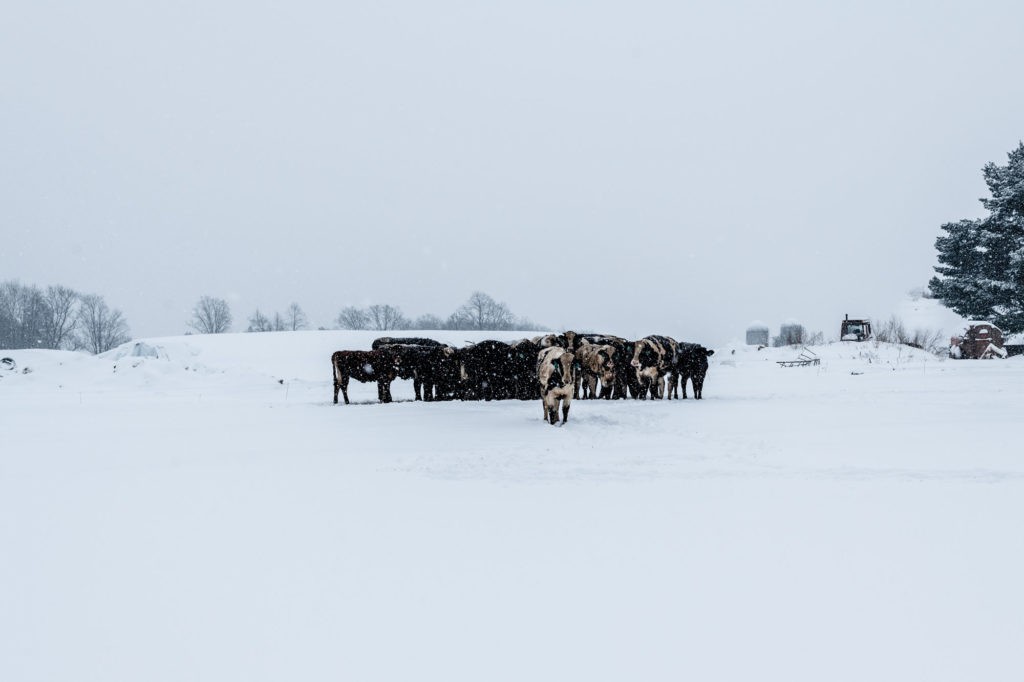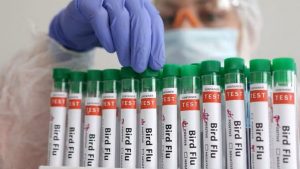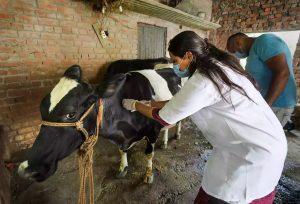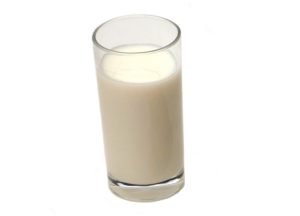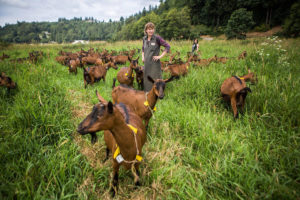Even buried in a winter’s worth of snow, Medford is picturesque. The railroad tracks that once led to town have been transformed into the Pine Line, a trail that runs 26 miles through the surrounding forests – the south central edge of Wisconsin’s Northwoods.
The Black River, a meandering tributary of the Mississippi, flows alongside it. And nearby, in the fields that dot the countryside, weathered wood barns stretch toward the sky.
Some of those barns stand empty, though. And others could be abandoned before the year’s end – because the farmers who live in or near Medford, like others throughout the state, are fighting for their livelihoods.
Between late 2014 and early 2015, the average price that Wisconsin dairy farmers earned on milk plummeted by about a third and remained at or near historic lows for years before recovering somewhat in late 2019. After factoring in expenses, some farmers are actually losing money on the milk they produce. Others earn so little that they feel compelled to produce far more than they normally would, knowing full well that by flooding the market, they’re contributing to the punishingly low prices.
Meanwhile, their costs have crept upward. Not all of them own the land they farm, and as local real estate values soar, so do their rents. The machinery they depend on gets more expensive to buy and maintain each year. And their health insurance does, too.
As a result, farms have been failing. According to the U.S. Department of Agriculture, 818 shut down in 2019, meaning that about 10% of the 8,110 farms around at the beginning of the year are now gone. Most of them have been small, like those you see around Medford.
Some politicians have taken action to prevent more farms from going under. In his State of the State address in January, Gov. Tony Evers called for a special legislative session (shortly after press time) for lawmakers to take up a suite of bills to address the crisis.
Others, however, believe that throwing out a lifeline will only delay the inevitable. U.S. Agriculture Secretary Sonny Perdue said as much when he visited the World Dairy Expo in Madison last year: “In America, the big get bigger, and the small go out.”
If Perdue is right, many more Wisconsin farms will eventually fail. And the rustic barns surrounded by grazing cows that have so long epitomized America’s Dairyland will continue to disappear.
Spilt Milk
What caused the dairy crisis in the first place? The short answer: it’s complicated. The somewhat longer answer:
QUOTAS
Between 1984 and 2015, the European Union capped the amount of milk that its dairy farmers could sell in a year. When the quota system was eliminated, European farmers began producing, and exporting, far more milk and cheese. Other countries have also amped up their dairy exports in recent years, creating more competition for U.S. farmers.
TARIFFS
When Donald Trump’s administration placed new tariffs on goods like steel and aluminum imported to the U.S. from other countries, many of those countries retaliated by introducing tariffs of their own on dairy products. Mexico, for instance, placed a 25% tariff on American cheese. Myriad factors play into exports, but American farmers sold around $566 million in dairy products abroad during their best month in 2015, and less than $364 million during their worst month in 2016.
CO-OPS
More than a century ago, farmers started joining dairy co-ops to collectively bargain for better prices. But some farmers believe that the co-ops have begun engaging in anti-competitive practices (making deals with other co-ops not to compete for members, for instance, and signing restrictive contracts with processors) that have lowered milk prices. In 2018, the largest co-op – the Dairy Farmers of America – paid $50 million to settle a class action lawsuit alleging as much.
DAIRY ALTERNATIVES
Plant-based dairy alternatives – like those made from almonds, coconuts, oats, rice or soy – have become increasingly popular. Collectively, those products were valued at around $16 billion globally, and they’re projected to top $38 billion by 2024.
A PAIR OF TWO-LANE HIGHWAYS lead in and out of Medford, a town of 4,300, and farms are a common sight along both. Clusters of silos half-obscured by trees. Clotheslines flapping in front of farmhouses. Two-story barns with sloping rooflines.
One of those farms – one with white barns and a tire swing out front – belongs to the Klussendorf family. Ryan, 37, is broad-shouldered and soft-spoken. Cheri, also 37, has large brown eyes and an easy laugh. Both are third-generation dairy farmers who spent their childhoods – Ryan in North Prairie, Cheri in Seymour – looking after cows, caring for them from their first steps to their last. And when they were old enough to choose careers for themselves, they decided that they wanted to follow in their parents’ and grandparents’ footsteps. They met at the Wisconsin School for Beginning Dairy and Livestock Farmers, a series of courses offered through UW-Madison’s agricultural college. (They’ve repeatedly returned to talk with current students about their experiences.) After completing the program, they got married and began looking for a place of their own. In 2006, they found land in Medford. Since then, the Klussendorfs have been recognized for their good work by agricultural organizations around the state, including the Wisconsin Farm Bureau Federation’s Young Farmer Achievement Award. Ryan now serves on that bureau’s board.
In short, they were model students. And now they’re model farmers. But even for them, the past five years have been a struggle. “I do feel it’s harder to be a farmer nowadays,” Ryan says. “We’ve been able to get by, but we haven’t had the funds to reinvest in the business.” He and Cheri have had to make some sacrifices since milk prices plummeted, putting off equipment purchases and forgoing family trips. But by keeping their expenses low and their level of efficiency high (they let their cows graze to cut down on their overall costs and labor requirements), they’ve managed to remain profitable.
Their days typically begin the same way. They wake around 5 o’clock in the morning, when it’s still dark outside, and a canopy of stars hangs high above their property. “There are some days I really don’t feel like getting out of bed because I’m not getting paid what I should be getting paid, and I can’t cover all my bills,” Ryan says.
But he can’t sleep in, because his cows, and his family members, are counting on him to keep the farm running. “You’re working with living, breathing animals,” he says. “There’s death, sickness. You’ve got to deal with all of that and care for the animals – try to do the best things for them.”
So he gets dressed and slips outside, before the sun has begun to slant across the surrounding fields. And then he gets to work. In the warmer months, he heads to the pasture where his cows sleep overnight and leads them up to the farm’s milking parlor, a huge space full of whirring machinery that looks a little like the bridge of the USS Enterprise. It takes him about an hour to milk their 100 cows. Then he gets ready to feed them. Allowing the cows to graze during the day – a somewhat unusual practice on modern farms – reduces the time Ryan needs to spend on farm chores. But the animals still need to be fed in the morning. He starts with the cows, then moves on to the calves and heifers, and is typically ready for other chores around 8 or 9 a.m.Meanwhile, Cheri helps their three sons get ready for school. Max, Owen and Kale are 11, 13 and 15, respectively, and they all want to be farmers when they grow up. “That’s all they’ve talked about since they were little,” she says.
Cheri then heads to her job at Riesterer & Schnell, a John Deere dealership. She took the position five years ago, and now that salary is a major source of income for the family and one of the key reasons that the Klussendorfs are weathering the dairy crisis better than many of their friends. “There are times where we’re sitting there, and I’m like, ‘This is really bad. I don’t know how I’m going to cover the bills this month,’” she says. “And then we talk to someone else, and they’re like, ‘Well I’m $50,000 in debt from last year.’”
Cheri visits dozens of farms, of all types and sizes, around the state. And though she ostensibly makes the trips to show her clients how they can use data to manage their properties more efficiently, she often ends up acting as a de facto counselor. “If you go to a farm that’s really struggling, 90% of the conversation might be about how they’re doing,” she says, “because they just need to vent.” In his role as WFBF board member, Ryan also hears from unhappy farmers. And both Klussendorfs take what they hear seriously. “You know they’re reaching out to you because you’re their friend,” Cheri says. “And they know that they can trust you, and that you’re going to listen to them and not judge them, and you’re not going to tell them to sell their farm.”
The struggle takes an emotional toll. Many in rural Wisconsin know or know of a farmer who has taken their own life. The suicide rate among male farmers in 2015 was 32.2 per 100,000, almost three times higher than that of the general population, according to the Centers for Disease Control and Prevention. Organizations like the Wisconsin Farm Center offer mental health services for farmers and a counseling voucher program, but not everyone who needs help seeks it out. And sometimes those who do don’t get the kind of support they were hoping for.
Brittany Olson, a fifth-generation farmer in the Eau Claire area who knows Ryan through his policy work, is open about how taxing the dairy crisis has been. “It’s definitely isolating,” she acknowledges. “It’s hard when you go to the doctor and you explain what’s going on, and she says, ‘Well, why don’t you just sell your cows?’”
Cheri agrees. “You worked so hard for what you have in that barn. People say, ‘Well, it’s just a cow.’ No! It’s a cow. You have relationships with those cows.”
Milk Prices and Milk Cow Herds
BOTH KLUSSENDORFS ARE QUICK to point out that farming isn’t all doom and gloom. The relationships with their animals are important to them, as is the satisfaction of being able to earn a living off of their land. In spite of the sense of uncertainty that hangs like a dark cloud over the industry, they love what they do. And they hope their children will be able to follow in their footsteps.
“There still are positives, there really are – we’re all getting together and we’re starting to fight for what we want,” Cheri says, explaining that the dairy crisis has helped rally local farmers around a common goal. “It’s not pitting the large farm against the small farm anymore, because everybody’s suffering. It’s not pitting organic against conventional, because everybody’s suffering. Everybody wants a fix.”
And other positives have appeared in recent months. Milk prices have been trending upward. Agricultural support programs are receiving more funding. And some industry insiders are cautiously optimistic that Wisconsin may finally be able to put the dairy crisis in its rearview mirror. If that’s the case, the Klussendorfs will be able to continue farming for many years to come. And the herds of cattle grazing the rolling hills of Medford will stay right where they are.
Milk Money
A by-the-numbers breakdown of the state’s dairy supply:
170
The number of cows on the average Wisconsin dairy Farm.
$16.50
The amount that local farmers received per 112 pounds of milk in 2018, when dairy prices had bottomed out.
ZERO
The amount of Limburger cheese made in the United States outside Wisconsin.
$45 BILLION
The Dairy industry’s annual contribution to the state’s economy, according to the Dairy Farmers of Wisconsin. That’s more than Florida gets from its citrus groves.
1:5
The approximate ratio of cows to humans in America’s Dairyland.
154,000
The number of jobs supported by the dairy industry in Wisconsin. The dairy industry accounts for about 44% of the state’s agriculture economy.
23
The percentage of U.S. dairy farms located in Wisconsin in 2018.
2.8 BILLION
Pounds of cheese produced in Wisconsin each year. Around 90% of the milk that Wisconsin dairy farmers produce is used by cheesemakers.

